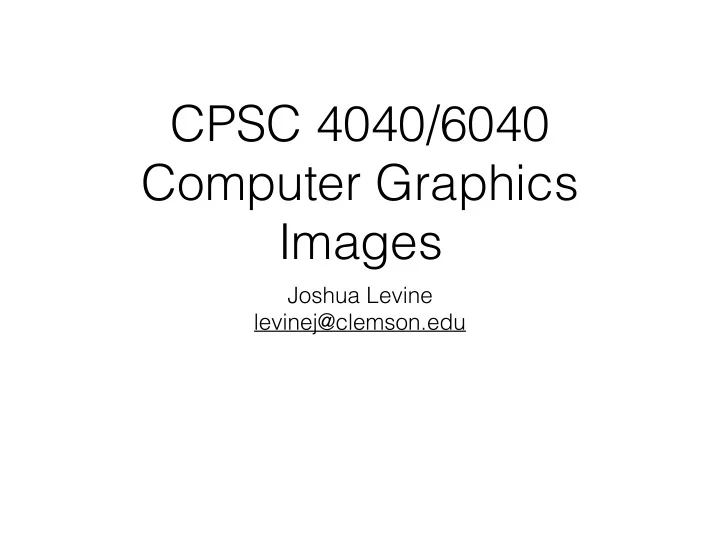

CPSC 4040/6040 Computer Graphics Images Joshua Levine levinej@clemson.edu
Lecture 20 Removing Warp Artifacts Nov. 5, 2015 Slide Credits: Szymon Rusinkiewicz
Agenda
Refresher from Lec19
Projective Warps • What is the matrix? • What the knowns? Unknowns? How many?
Algebra • A general 3x3 matrix can express this entire class of warps (9 unknowns) • a 33 acts as a global scale parameter, so we can always set it to 1 without losing generality • The remaining 8 unknowns can be solved by 4 pairs of equations using the 8 known x i , y i values and the 8 known u i , v i values • Solving these 8 equations gives the 8 remaining a ij unknowns
Bilinear Warping • Key Idea: Instead of using bilinear interpolation for pixel color values, we can use it to interpolate the positions in the warped image
Step 2: Forward Warp with u,v offsets
Inverse Bilinear Warp Can Be Computed from the Forward Warp • Forward warp for a pixel (s, t) is equivalent to the following equations: • where (s 0 , t 0 ) is the lower left of the image, (s 1 , t 1 ) is the upper right of the image, and (effectively normalizing)
Inverse Bilinear Warp Can Be Computed from the Forward Warp • Taking the inverse of • Leads to • Where 0<u<1, 0<v<1, and
Recall: Converting Between Image Domains • When an image is acquired, an image is taken from some continuous domain to a discrete domain. • Reconstruction converts digital back to continuous through interpolation. • The reconstructed image can then be resampled and quantized back to the discrete domain.
Fixing Jaggies / Magnification Artifacts
Reconstruction Artifacts • Leads to staircasing or “jaggies”
Do a Better Reconstruction? • Basic Idea: If we interpolate the data samples better we will have a superior reconstruction • How? Bilinear Interpolation, Bicubic, etc.
Recall: Nearest Neighbor
Recall Bilinear Example
Recall Bicubic (from Photoshop) Ignore small color issues
Fixing Aliasing / Minification Artifacts:
Aliasing Artifacts • Aliasing leads to missing and/ or unwanted features • Example: 12x12 images scaled to a 4x4 image.
Aliasing • When we minify, we use only a few samples to represent lots of data • High frequencies “masquerade” as low ones � • Images look “ropey”. This is not jaggies! Inadequate sampling (Barely) adequate sampling
Aliasing Described by Sampling Theory • What happens if we use too few samples? � • Aliasing: when high frequencies masquerade as low ones
How many samples are enough to avoid aliasing? � How many samples are required to represent a given signal without loss of information? � What signals can be reconstructed without loss for a given sampling rate?
How many samples are enough to avoid aliasing? � How many samples are required to represent a given signal without loss of information? � What signals can be reconstructed without loss for a given sampling rate?
How many samples are enough to avoid aliasing? � How many samples are required to represent a given signal without loss of information? � What signals can be reconstructed without loss for a given sampling rate?
How many samples are enough to avoid aliasing? � How many samples are required to represent a given signal without loss of information? � What signals can be reconstructed without loss for a given sampling rate?
How many samples are enough to avoid aliasing? � How many samples are required to represent a given signal without loss of information? � What signals can be reconstructed without loss for a given sampling rate?
Antialiasing Filters • Basic Idea: Smooth the image first to reduce the overall frequency • How? Use filters!
Resampling with Filters • Output is weighted average of inputs: float Resample(src, u, v, k, w) { float dst = 0; float ksum = 0; int ulo = u - w; etc. for (int iu = ulo; iu < uhi; iu++) { for (int iv = vlo; iv < vhi; iv++) { dst += k(u,v,iu,iv,w) * src(u,v) ksum += k(u,v,iu,iv,w); } } (u,v) f return dst / ksum; (ix,iy) } Source image Destination image
Local Convolution? • Compute weighted sum of pixel neighborhood � Output is weighted average of input, where weights are normalized values of filter kernel (k) dst(ix,iy) = 0; for (ix = u-w; ix <= u+w; ix++) for (iy = v-w; iy <= v+w; iy++) d = dist (ix,iy) ������ dst(ix,iy) += k(ix,iy)*src(ix,iy); (u,v) w d (ix,iy) k(ix,iy) represented by gray value
Smoothing an Image in This Way Limits the Frequency Bands Point Sampled: Aliasing! Correctly Bandlimited
Another Approach • Instead of smoothing, we can also sample better and then aggregate the samples
Artifact “Free” Warping Pipeline
Warping Pipeline Real world • Ideal resampling Sample requires correct filtering Discrete samples (pixels) to avoid artifacts Reconstruct • Reconstruction filter Reconstructed function especially important Transform when magnifying Transformed function • Bandlimiting filter Filter especially important Bandlimited function when minifying Sample Discrete samples (pixels) Reconstruct Display
Lec21 Required Reading
• House, Ch. 13
Recommend
More recommend